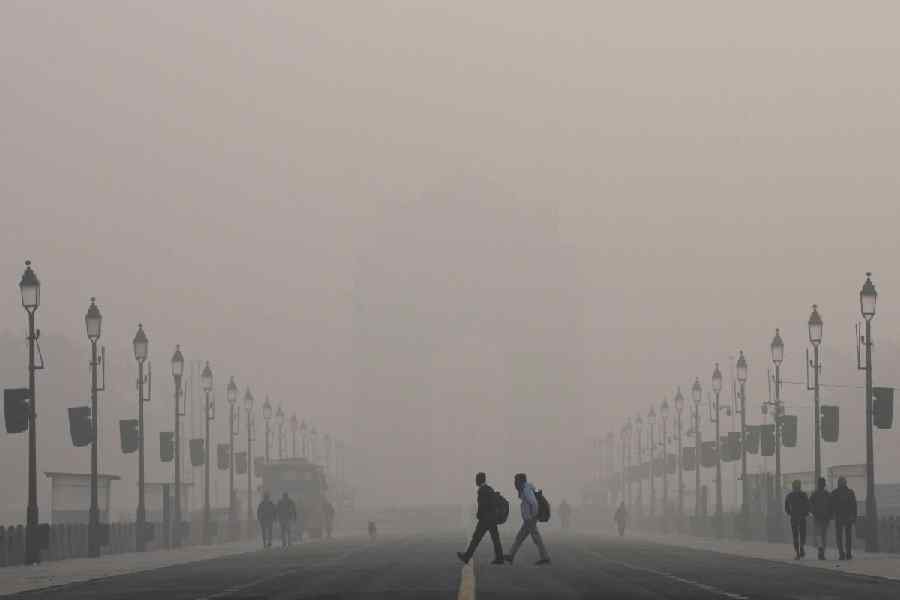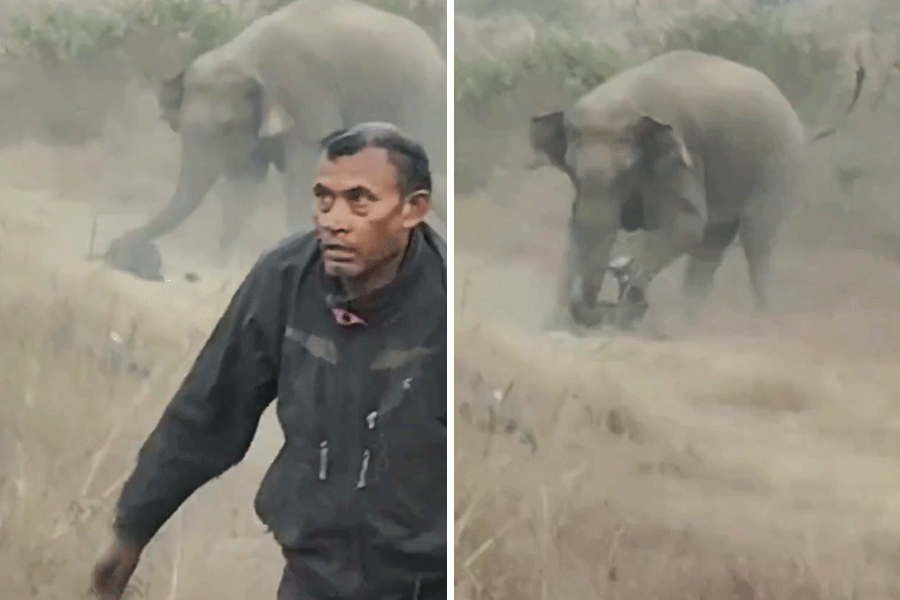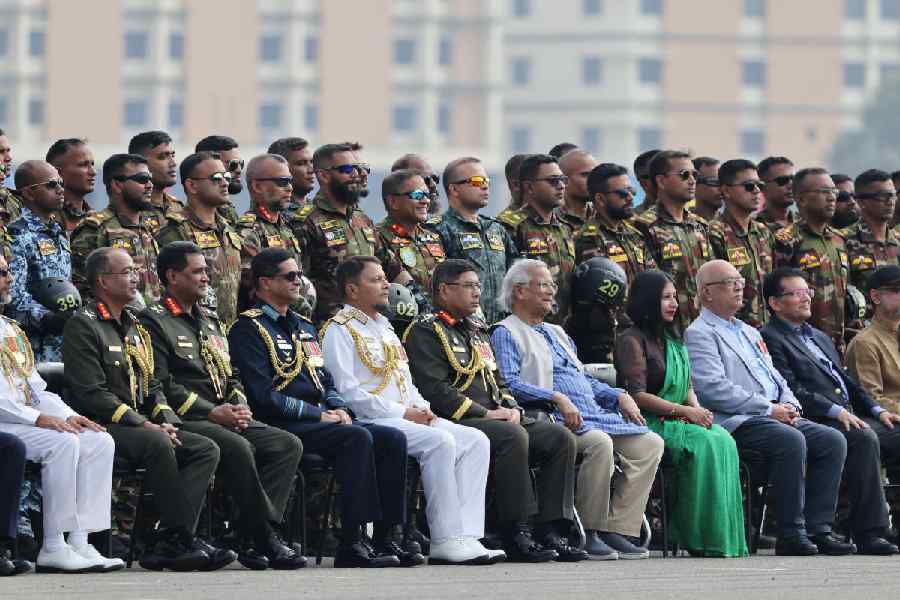 |
Durga pujor hawa — the smell of Durga Puja.
Ashwiner majhamajhi,
Uthilo bajna baaji
Pujor shomoy elo kachhey,
Modhu, Bidhu dui bhai, chhota-chhuti korey tai
Anondey du haath tuli nachey…
I always associate Durga Puja with this Tagore poem. Brothers Modhu and Bidhu are eager to see the new clothes they’ll be gifted for Puja. Their mother smiles and presents them with a set of simple clothes. That’s all, asks an angry Modhu, flinging them away. He cries and says, “I don’t want them, Ma. Ray Babu’s Gupi has been given a gold threaded cap and a floral shirt in satin…”
Getting new clothes is a part of this festival and craving more is only natural. When I was a kid my mom would invariably quote these lines to stop me from being obsessive about wanting more. For some strange reason these lines got so entrenched in my mind that throughout my life they’ve made me never ask for more. Not that the craving has stopped but the discipline of “not asking for more” has always been more powerful.
Getting back to talking about Puja, I really need to recollect when I last thoroughly enjoyed the Puja. It all seems so long ago and far away — when I was in Calcutta, in the late 1960s perhaps…
 |
Please pardon me for not being cohesive — but I am just going to glide through the past and try to actually find out myself what Puja means to me. The excitement of Puja approaching was often more exciting than everything else.
I grew up in an orthodox Bengali family. I was over-protected and, therefore, excessively looked after. There were too many dos and don’ts in life. That perhaps made me quite an introvert — and it was during Puja that I used to go out and enjoy myself as much as I could. It gave me a sense of freedom.
I remember being, at times, allowed to see theatre in our local para (neighbourhood) Puja pandal through the night and that used to be a major high point for me during the festive days. I remember actors barging onto the stage through the audience — it used to be so interactive and exciting.
 |
I used to enjoy the dance of the dhakis during the arati and also the bhog. But I was never allowed to go for bhashan (the immersion). Something in our family restricted us from going there.
Apart from this, there was another very interesting aspect of the Puja — chutiye adda and jomiye prem (endless addas and passionate love). No elder would oppose this — perhaps they were reminded of their own days…
Adding to this were the new romantic song releases, which used to act as catalysts — Hemanta Mukhopadhay, Arati Mukhopadhay, Aparesh Lahiri, Shyamal Mitra…
Love seemed to be there in the air through those seven days!
And then in 1971 I had to leave Calcutta... Now that’s another story, which someday I intend to tell.
Being a “probashi Bengali” (a Bengali living outside Bengal) almost throughout my life, it never was the way it used to be in Calcutta. After leaving Calcutta in 1971, Delhi was like a different country. It took me time getting used to it. But thankfully, during Puja the same “Pujor hawa” (the Puja smell) of Calcutta used to be there in the air! Or perhaps it was in my mind…
That faint nip in the air and that strange feeling of chhuti (holidays) was always there during the Pujas. The smell of new clothes in the morning, the satisfied burp of bhaat and mangsho (rice and mutton curry) in the afternoon and the intoxicating smell of dhoop (incense) in the evening arati — that’s the Puja I would like to remember always…
After coming away from Calcutta, that quintessential essence of Puja slowly diminished for me. Perhaps it is also to do with growing older and getting more into the business of handling life. Or perhaps it was more about moving away from your roots.
I often wonder whether my children will ever get that “Puja smell”. It is perhaps my job to make them get it. Otherwise they would miss out on something so Bengali!
 |
Come to think of it, perhaps to get that particular old traditional flavour of the festival, I often visit Puja in what I dare to create. I tried to recreate Puja in a number of ads and music videos, but recreating it in Parineeta was my dream come true. It was such a joy re-living Calcutta of the 1960s and what is Calcutta without the Pujas?
For all my quintessential Durga Puja a thakurdalan was a must and that I found in north Calcutta. The strangest thing about this area of Calcutta is that it hasn’t changed since perhaps the British Raj!
In Parineeta I had used Puja as a time travel device. I’ve shown Puja a number of times to take a few leaps in the story telling process. In one Puja, Shekhar (Saif Ali Khan) realises his love for Lolita. In another Puja, a few years later, he feels his jealousy.
 |
| THAT FESTIVE FEELING: Pradeep Sarkar and stills from Parineeta |
The last Puja scene that I used in the film was that of woman empowerment. Along with Ma Durga’s face getting immersed in the waters, I faded in Lolita’s face in full bridal glory. Her face was full of confidence and power — she became a “Married Woman” that day — she became Parineeta. The power of Ma Durga was in her.
Perhaps this is one of the reasons why I am so satisfied with Parineeta. Through this film a bit of Bengal would always be alive, for my children to enjoy.
Perhaps someday they might just get that Puja “smell” which I get every time around this time of the year…
Shei pujor hawa!
Pradeep Sarkar is the director of the 2005 film Parineeta. His other films include Lafangey Parindey (2010) and Laaga Chunari Mein Daag (2007)











